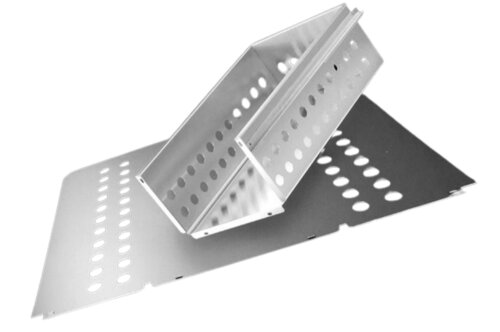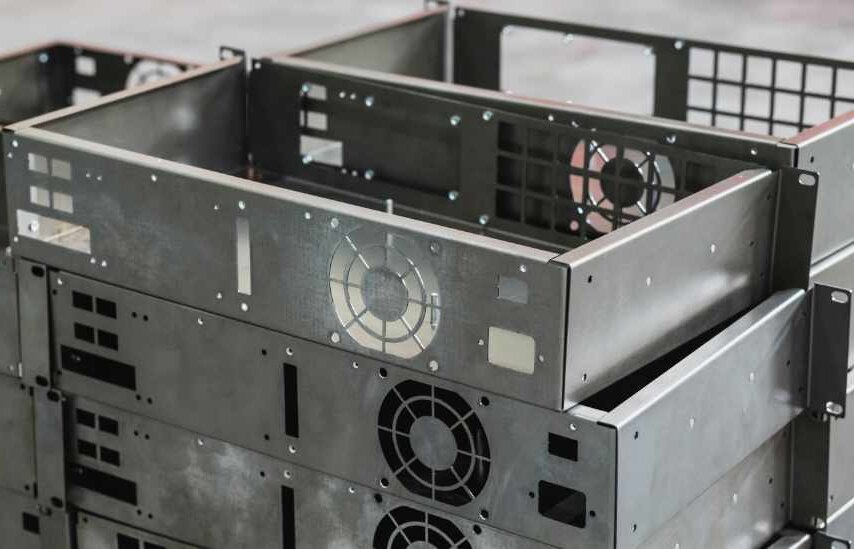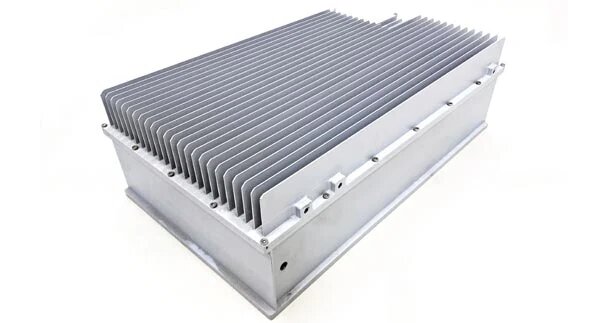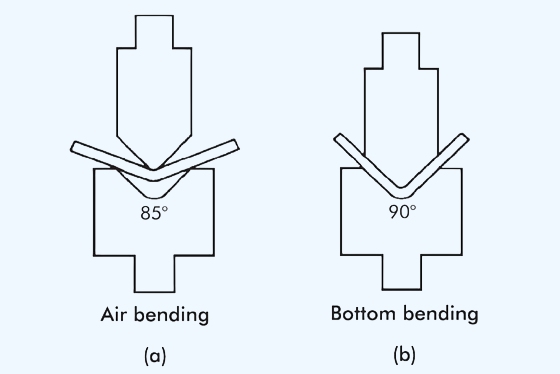نظرًا لأن الأنظمة الإلكترونية وأنظمة الطاقة أصبحت أصغر حجمًا وأكثر قوة، فقد أصبح التحكم في الحرارة داخل حاويات الصفائح المعدنية تحديًا هندسيًا كبيرًا. فحتى الزيادة المعتدلة في درجة الحرارة بمقدار 10 درجات مئوية يمكن أن تقلل من عمر المكونات الإلكترونية بحوالي 50 درجة مئوية تقريبًا، مما يؤدي إلى فشل سابق لأوانه ووقت تعطل مكلف.
يبدأ التبديد الفعال للحرارة في حاويات الصفائح المعدنية بفهم كيفية انتقال الحرارة - من خلال التوصيل والحمل الحراري والإشعاع - وكيف يمكن تحسين كل منها من خلال خيارات المواد والتصميم المبتكرة.

كيف تتحرك الحرارة في حاويات الصفائح المعدنية?
داخل الضميمة، تتسرب الحرارة من خلال ثلاثة مسارات رئيسية: التوصيل (الأسطح المعدنية)، والحمل الحراري (حركة الهواء)، والإشعاع (انبعاث السطح). الموازنة بين المسارات الثلاثة تمنح النظام تحكمًا مستقرًا وموثوقًا في درجة الحرارة.
التوصيل - نقل الحرارة عبر المعدن
التوصيل هو أسرع طريق لخروج الحرارة من المكونات الداخلية. تعمل الجدران المعدنية كجسر حراري ينقل الطاقة الحرارية من المصدر إلى البيئة الخارجية.
يقوم الألومنيوم بتوصيل الحرارة أفضل بأربعة أضعاف تقريبًا من الفولاذ المقاوم للصدأ (≈ 205 واط/م-ك مقابل 50 واط/م-ك)، مما يجعله الخيار الأفضل للحاويات عالية الكفاءة. حتى التحسينات الطفيفة في جودة التلامس الجداري - مثل استخدام الوسادات الحرارية أو الشحوم - يمكن أن تقلل من مقاومة التلامس بمقدار 10-30 %، مما يخفض درجة حرارة السطح مباشرةً.
نصيحة تصميم: قم بزيادة التلامس المعدني إلى أقصى حد بين الأجزاء المولدة للحرارة وألواح الضميمة.
لماذا يعمل: تعمل الواجهة الضيقة والمسطحة على التخلص من الفجوات الهوائية العازلة، مما يحسن التوصيل ويقلل من تراكم البقع الساخنة.
الحمل الحراري - نقل الحرارة من خلال تدفق الهواء
ينقل الحمل الحراري الحرارة عن طريق تدوير الهواء داخل الضميمة. في الحمل الحراري الطبيعي، يرتفع الهواء الدافئ من خلال فتحات التهوية بينما يدخل الهواء البارد من الأسفل - وهو أمر بسيط ولكنه محدود بكثافة الهواء والهندسة. يزيد الحمل الحراري القسري، الذي يتم إنشاؤه بواسطة المراوح أو المنافيخ، من معدل تدفق الهواء ويمكنه تحسين إزالة الحرارة حتى 10 أضعاف مقارنة بالتدفق السلبي.
من الضروري وجود مسار تدفق هواء سلس. يجب أن يتحرك الهواء من منطقة السحب الأكثر برودة، عبر المناطق كثيفة الحرارة، ويخرج بحرية دون إعادة تدويره.
خطأ معياري: تركيب المراوح بالقرب من الجزء العلوي بدون فتحات سحب محددة - وهذا يعيد تدوير الهواء الساخن بدلاً من إخراجه، مما يقلل من كفاءة التبريد.
خلاصة سريعة:
- الحمل الحراري الطبيعي: بسيط وصامت ولكنه محدود
- الحمل الحراري القسري: قوي، ويحتاج إلى تحكم في التصميم
- مسارات هواء سلسة = مقاومة حرارية أقل
الإشعاع - إطلاق الحرارة من الأسطح
يشع كل سطح معدني الحرارة إلى الخارج، لكن كفاءته تعتمد على مساحة السطح والانبعاثية. ويعكس المعدن اللامع أو المصقول طاقة الأشعة تحت الحمراء ويشع بشكل ضعيف (ε ≈ 0.05-0.2). التشطيبات غير اللامعة، أو طلاءات سوداء، يشع ما يصل إلى أربع مرات أفضل (ε ≈ 0.8-0.9).
يمكن للطلاء المؤكسد الداكن أو المطلي بالمسحوق أن يخفض درجة حرارة سطح الضميمة بمقدار 10-15 درجة مئوية، خاصة في أنظمة الحمل الحراري الطبيعي. إضافة زعانف أو اللوفرات يزيد من المساحة، مما يعزز كلاً من الإشعاع والحمل الحراري؛ قد تؤدي مضاعفة مساحة السطح الفعالة إلى تقليل درجة الحرارة الداخلية بمقدار 15-25 درجة مئوية، اعتمادًا على إجمالي الحمل الحراري.
نصيحة تصميم: اجمع بين الطلاء غير اللامع وزيادة مساحة اللوحة للحصول على أفضل نتائج تبريد سلبي.
لماذا يعمل: تطلق المواد ذات الانبعاثية الأعلى حرارة أكثر لكل وحدة مساحة، مما يسرع من الفقد الإشعاعي والحمل الحراري.
خيارات تصميم المواد والأسطح التي تحسن الأداء الحراري
يحدد اختيار المعدن والتشطيب المناسبين بشكل مباشر مدى كفاءة الضميمة في التعامل مع الحرارة.
اختيار المعادن عالية التوصيل
| المواد | الموصلية الحرارية (وات/م كلفن) | التطبيق النموذجي |
|---|---|---|
| نحاس | ~385 | موزعات الحرارة المحلية ووحدات الطاقة |
| الألومنيوم | ~205 | حاويات الأغراض العامة |
| نحاس | ~120 | التركيبات الجمالية أو الهجينة |
| الفولاذ المقاوم للصدأ | 16-50 | حاويات مقاومة للتآكل |
يوفر الألومنيوم أفضل نسبة من الوزن والتكلفة والأداء. النحاس مثالي لنقل الحرارة الموضعي ولكنه يضيف التكلفة والكثافة. بالنسبة للتصميمات الهجينة، تستخدم العديد من الشركات المصنعة الفولاذ المقاوم للصدأ للهيكل وألواح الألومنيوم للتبريد - تجمع بين القوة والتوصيل.
نصيحة تصميم: عندما يتجاوز الحمل الحراري 30 واط لكل لتر من حجم الضميمة، قم بالتبديل من الفولاذ المقاوم للصدأ إلى الألومنيوم أو أضف مسارات حرارة من الألومنيوم.
لماذا يعمل: تحتاج الكثافة الحرارية العالية إلى توصيل أسرع لتجنب التدرجات الحرارية الحادة.
تحسين سمك الجدار والهيكل الأمثل
وتحتفظ الجدران السميكة بالحرارة بشكل أكبر؛ أما الجدران الرقيقة فتطلقها بشكل أسرع ولكنها قد تنثني أو تهتز. ويوازن سمك الجدار الذي يتراوح بين 1.5 و2.5 مم بشكل عام بين الثبات الميكانيكي والتوصيل الفعال.
إذا كانت القوة الهيكلية أمرًا بالغ الأهمية، أضف أضلاعًا داخلية أو حوافًا مطوية بدلاً من الألواح السميكة - للحفاظ على الصلابة دون التعرض لعقوبة حرارية.
تشطيبات السطح والطلاءات لتحسين إطلاق الحرارة
تؤثر المعالجات السطحية على كل من الانبعاثية ومقاومة التآكل.
- طلاء بأكسيد أسود غير لامع → إشعاع ممتاز، استخدام داخلي.
- طلاء المسحوق (لون فاتح) → تعكس أشعة الشمس، مثالية للاستخدام الخارجي.
- تشطيبات مصقولة أو مصقولة بالخرز → توازن جيد بين الجماليات والتحكم في الحرارة.
يساعد اختيار الطلاءات وفقًا للبيئة على التحكم في درجة الحرارة بشكل طبيعي، دون استهلاك طاقة إضافية.
تصميم مسار التهوية وتدفق الهواء
تدفق هواء فعال يحول الصندوق المغلق إلى نظام تبريد. تعلّم كيف يحافظ وضع الفتحات الذكية واتجاه المروحة على تشغيل كل مكوّن بهدوء وثبات.
التهوية السلبية
تستخدم التهوية السلبية الحمل الحراري الطبيعي، حيث يرتفع الهواء الساخن ويخرج من خلال الفتحات بينما يدخل الهواء البارد من الأسفل. إنه بسيط وخالٍ من الطاقة ومثالي للتصميمات ذات الكثافة المنخفضة إلى المتوسطة.
مبادئ التصميم
- منطقة التنفيس: يجب أن تمثل الفتحات ما لا يقل عن 10-15% من إجمالي مساحة سطح الضميمة للأحمال الحرارية المعتدلة.
- التنسيب: ضع فتحات السحب بالقرب من الأسفل وفتحات العادم بالقرب من الأعلى أو الخلف لدعم تدفق الهواء العمودي.
- الاصطفاف: يجب أن تكون فتحات السحب والعادم متباعدة بما فيه الكفاية لمنع حدوث قصر في تدفق الهواء.
نصيحة تصميم: ضع فتحات العادم فوق المكونات المولدة للحرارة مباشرة.
لماذا يعمل: يتماشى ذلك مع مسار الحمل الحراري الطبيعي، مما يسمح للحرارة بالخروج بشكل أسرع دون الاعتماد على المراوح.
هندسة الفتحات والأداء
يؤثر شكل ونمط الفتحات بشكل كبير على كفاءة التبريد:
- فتحات التهوية توجيه تدفق الهواء بشكل اتجاهي مع الحماية من دخول الماء.
- الثقوب توزيع الهواء بالتساوي مع الحفاظ على القوة.
- فتحات مقطوعة بالليزر توفر مرونة للتصميمات الجمالية أو الدقيقة، ولكن يجب أن تتضمن حواف مستديرة لتجنب التشقق الإجهادي أثناء الثني.
تُظهر اختبارات نفق الرياح أن استبدال الفتحات الدائرية بفتحات انسيابية يمكن أن يزيد من تدفق الهواء بمقدار 20-25% تحت الضغط نفسه.
خلاصة سريعة:
- الحمل الحراري الطبيعي = مجاني وصامت.
- تباعد مناسب بين الفتحات = تدفق هواء أفضل.
- تحسين الهندسة = حاوية أقوى وأبرد.
التبريد النشط
عندما لا يكون تدفق الهواء الطبيعي غير كافٍ، يضمن الحمل الحراري القسري تبادل هواء ثابت. تعمل المراوح والمنافيخ على تسريع التبريد، وتحافظ على درجات حرارة متساوية، وهي ضرورية في العبوات المدمجة أو المغلقة ذات الأحمال الداخلية العالية.
اختيار إعداد المروحة المناسب
يجب أن يتطابق اتجاه تدفق الهواء مع الحمل الحراري الطبيعي - عادةً من الأسفل إلى الأعلى أو من الأمام إلى الخلف. تقوم المراوح بدفع الهواء البارد فوق المكونات الأكثر سخونة أولاً، ثم تقوم باستنفاده بكفاءة.
- مراوح موازية: زيادة حجم تدفق الهواء (للخزانات العريضة).
- عشاق المسلسلات: زيادة الضغط الساكن (للحاويات العميقة أو المعقدة).
- قاعدة معدل التدفق: Q=3.16×P/ΔT
حيث: س = تدفق الهواء بوحدة CFM, P = الحرارة بالواط, 𞸍 = ارتفاع درجة الحرارة المسموح به (درجة مئوية).
على سبيل المثال، تتطلب ضميمة بقدرة 400 واط مع حد ارتفاع 10 درجات مئوية ≈126 CFM من تدفق الهواء.
نصيحة تصميم: حدد دائماً مساراً واضحاً للعادم قبل إضافة المراوح.
لماذا يعمل: يتسبب تدفق الهواء غير المنضبط في إعادة تدوير الهواء، مما يقلل من فعالية المروحة ويزيد من التباين في درجة الحرارة الداخلية.
وضع المروحة والتحكم في الضوضاء
ضع مراوح السحب بالقرب من المناطق الأكثر برودة ومراوح العادم بالقرب من النقاط الأكثر سخونة. استخدم مراوح منخفضة السرعة في الدقيقة وذات قطر كبير في البيئات الصناعية أو المكتبية - فهي تحرك المزيد من الهواء بضوضاء أقل. يمكن أن تؤدي إضافة حواجز أو موجهات هواء إلى سلاسة تدفق الهواء وتقليل الاضطراب وتحسين التوحيد الحراري بما يصل إلى 15%.
خطأ معياري: وضع جميع المراوح على جانب واحد. هذا يخلق ضغطًا غير متساوٍ و"مناطق ميتة" حيث يبقى الهواء الساخن.
نصيحة تصميم: قم بإقران مراوح السحب والعادم بشكل مائل عبر الضميمة.
لماذا يعمل: تضمن أنماط التدفق المتقاطع تغطية هواء موحدة وتبريد أفضل للتخطيطات المكتظة بكثافة.
التخطيط الداخلي وإدارة النقاط الساخنة
يحدد تصميم المكونات الداخلية مدى قدرة الهواء على الدوران. يمكن لوحدات الطاقة أو المحولات الكبيرة أن تسد تدفق الهواء، مما يشكل مناطق ميتة تؤدي إلى ارتفاع درجة الحرارة.
أفضل ممارسات التخطيط الأفضل
- اترك مسافة خلوص 25-30 مم على الأقل حول الأجهزة عالية الحرارة.
- قم بمحاذاة المكونات على طول اتجاه تدفق الهواء نفسه بدلاً من أن تكون متعامدة.
- استخدم عواكس الهواء أو الحواجز لتوجيه الهواء إلى المساحات الضيقة.
تُظهر الاختبارات الحسابية أن مجرد إعادة تنظيم المكونات الرئيسية لإزالة انسدادات الهواء يمكن أن يقلل من درجة الحرارة القصوى بمقدار 8-12 درجة مئوية دون تغيير الأجهزة.
نصيحة تصميم: افصل بين الأقسام عالية الحرارة والأقسام منخفضة الحرارة باستخدام حواجز أو فواصل جزئية.
لماذا يعمل: يتدفق الهواء بشكل طبيعي نحو مناطق الضغط المنخفض؛ ويمنع تقسيم المناطق إعادة تدوير الحرارة بين الأقسام.
الموازنة بين الكفاءة والضوضاء والصيانة
في حين أن المراوح تحسّن التبريد، إلا أنها تجلب معها الضوضاء وتكاليف الصيانة.
لإطالة العمر الافتراضي وضمان الموثوقية:
- اختر المراوح ذات العمر الافتراضي المقدّر بأكثر من 50,000 ساعة عند 40 درجة مئوية.
- قم بتركيب فلاتر قابلة للإزالة لسهولة التنظيف.
- تجنب الزيادات غير الضرورية في سرعة المروحة؛ فمضاعفة عدد الدورات في الدقيقة يمكن أن تضاعف مستوى الضوضاء أربع مرات دون تحقيق مكاسب تبريد متناسبة.
نصيحة تصميم: تنفيذ التحكم في سرعة المروحة باستخدام مستشعرات درجة الحرارة.
لماذا يعمل: يقلل الضبط الديناميكي للسرعة من استخدام الطاقة ويطيل عمر المروحة ويحافظ على أداء حراري ثابت.

دمج مكونات نقل الحرارة
لا يمكن للهواء وحده التعامل مع الأحمال الحرارية المركزة. استكشف كيف تنقل المشتتات الحرارية والوسادات الحرارية والأنابيب الحرارية الطاقة بسرعة للحفاظ على درجات حرارة موحدة.
المشتتات الحرارية ومواد الواجهات الحرارية (TIMs)
يزيد المشتت الحراري من مساحة السطح، مما يسمح للحرارة بالتشتت بكفاءة أكبر في الهواء المحيط. وعند إقرانه بمادة واجهة حرارية، فإنه يزيل فجوات الهواء المجهرية ويضمن أقصى قدر من التوصيل من سطح المكوّن إلى الحوض.
يمكن أن تؤدي إضافة بالوعة حرارية ذات حجم مناسب إلى تقليل درجة حرارة المكونات بمقدار 20-30 درجة مئوية، اعتمادًا على ظروف تدفق الهواء.
الاعتبارات الهندسية
- مادة: يتميز الألومنيوم بتوصيلية عالية (≈205 واط/م-ك) ووزن منخفض.
- تصميم الزعانف: زعانف عمودية للحمل الحراري الطبيعي.
- زعانف متقاطعة أو مسمارية لتدفق الهواء القسري.
- تباعد الزعانف: مساوٍ لارتفاع الزعنفة للحمل الحراري الطبيعي؛ مسافات أقرب لتصميمات التبريد بالمروحة.
نصيحة تصميم: قم بتركيب المشتتات الحرارية مباشرة على جدران الضميمة باستخدام وسادات حرارية أو شحم.
لماذا يعمل: ويصبح الجدار امتدادًا للمشتت الحراري، مما يضاعف سطح الإشعاع المتاح دون حجم إضافي.
اختيار TIM المناسب
تعمل مواد الواجهة الحرارية على ملء العيوب السطحية الصغيرة، مما يضمن التلامس الكامل بين مصدر الحرارة والمشتت. تشمل الأنواع الشائعة ما يلي:
- وسادات أساسها سيليكون: سهولة التجميع، أداء معتدل.
- شحم أو معجون: موصلية عالية، تتطلب تطبيقًا دقيقًا.
- أفلام تغيير الطور: ذاتية الانتشار في درجات حرارة عالية، مثالية لوحدات الطاقة.
يمكن أن يؤدي اختيار TIM مع توصيل حراري >3 واط/م-ك إلى تقليل مقاومة الوصلة إلى البالوعة بما يصل إلى 25%.
خطأ معياري: وضع الكثير من المعجون الحراري - تعمل المادة الزائدة كعازل وتقلل من الأداء.
الأنابيب الحرارية وغرف البخار
تقوم الأنابيب الحرارية وغرف البخار بنقل الحرارة باستخدام تغير الطور - حيث يتبخر السائل في الطرف الساخن ويتكثف في الطرف البارد، مما يؤدي إلى نقل الطاقة بسرعة. ويمكن أن تصل الموصلية الحرارية الفعالة لهذه الأنابيب إلى 10,000 واط/م-كس، وهو ما يفوق بكثير النحاس الصلب أو الألومنيوم.
تكامل التصميم
تُعد الأنابيب الحرارية مثالية لربط وحدات الطاقة بجدران أو زعانف التبريد، بينما تقوم غرف البخار بتوزيع الحرارة بالتساوي عبر الألواح المسطحة. وهي تتطلب الحد الأدنى من المساحة ولا تحتاج إلى مصدر طاقة.
دراسة حالة مصغرة: في وحدة تحكم بقدرة 250 واط، أدى أنبوبان حراريان مدمجان يوصلان قسم MOSFET للطاقة بالجدار الجانبي إلى خفض درجة الحرارة القصوى من 82 درجة مئوية إلى 57 درجة مئوية، بدون إضافة مراوح.
نصيحة تصميم: ضع الأنابيب الحرارية بشكل عمودي أو بميل لطيف.
لماذا يعمل: وتساعد الجاذبية على عودة السائل المكثف إلى مصدر الحرارة، مما يحافظ على استمرار التدوير الحراري.
خطأ معياري: معاملة الأنابيب الحرارية ككابلات مرنة. يؤدي ثنيها أو تسطيحها إلى إتلاف الشعيرات الدموية الداخلية وإيقاف دوران الطور.
التجسير الحراري وإدراج النحاس
عندما تحدّ المعادن الأساسية (مثل الفولاذ المقاوم للصدأ) من التوصيل الحراري، يمكن للجسور الحرارية أن تنقل الطاقة إلى مناطق عالية التوصيل. تعمل إضافة إدخالات أو قضبان أو وسادات نحاسية مباشرةً تحت المكونات عالية الحرارة على تحسين التوصيل المحلي بشكل كبير.
يحتوي الملحق النحاسي على ما يقرب من 8 أضعاف موصلية الفولاذ المقاوم للصدأ ويمكنه خفض ارتفاع درجة الحرارة المحلية بمقدار 30-40%.
مثال على التكامل
- قم بتضمين صفيحة نحاسية مشكّلة آليًا تحت وحدة الطاقة وتثبيتها بالبرايل أو ربطها بجدار الضميمة.
- استخدم وسادات حرارية بين النحاس والجدار للحفاظ على ضغط التلامس.
- يُدمج مع تدفق الهواء لتعزيز الإزالة بالحمل الحراري.
نصيحة تصميم: قصر المقاطع النحاسية على المناطق الساخنة الحرجة فقط.
لماذا يعمل: فهو يزيد من كفاءة التكلفة إلى أقصى حد مع توفير توصيل سريع في الأماكن الأكثر أهمية.
موزعات الحرارة والألواح الموصلة للحرارة
توزع صفائح الجرافيت أو صفائح الألومنيوم الموزعة للحرارة أفقياً عبر الألواح أو مركبات ثنائي الفينيل متعدد الكلور.
تتمتع هذه المواد فائقة النحافة (0.1-0.5 مم) بموصلية داخل المستوى تصل إلى 1500 واط/كلفن مما يسمح ببناءات مدمجة بدون حجم إضافي.
في الاختبارات، قللت صفائح الجرافيت من درجات حرارة البقعة الساخنة بمقدار 5-8 درجات مئوية في العبوات الكثيفة مع زيادة الوزن بأقل زيادة ممكنة.
نصيحة تصميم: ضع صفائح الموزعة تحت مركبات ثنائي الفينيل متعدد الكلور أو بين الوحدات المكدسة.
لماذا يعمل: تعمل على معادلة درجات حرارة السطح، مما يمنع السخونة الزائدة الموضعية التي لا يمكن أن يصل إليها تدفق الهواء.
الجمع بين الطرق لتحقيق أقصى قدر من الكفاءة
تجمع التصميمات الأكثر موثوقية بين آليات تبريد متعددة:
- TIMs ضمان الاتصال الجيد.
- بالوعة الحرارة توسيع مساحة السطح.
- الأنابيب الحرارية أو غرف البخار نقل الطاقة بعيدًا.
- الجسور النحاسية تسريع التوصيل.
- تدفق الهواء إكمال الدورة عن طريق إزالة الحرارة من النظام.
نصيحة تصميم: تعامل مع التصميم الحراري كسلسلة - أداء النظام يساوي أضعف حلقاته.
لماذا يعمل: مسار توصيل قوي بدون تدفق هواء (أو العكس) يحد من الكفاءة الإجمالية؛ ويضمن التآزر بين جميع العناصر تبريدًا متسقًا.

الموازنة بين تبديد الحرارة والحماية والقوة
يجب أن تتعايش الكفاءة الحرارية مع المتانة والعزل. تعرّف على كيفية الحفاظ على العبوات قوية ومحمية وباردة - حتى في البيئات الخارجية القاسية.
العبوات محكمة الغلق مقابل التصميمات ذات التهوية
العبوات محكمة الغلق ضرورية للبيئات المتربة أو الرطبة. ومع ذلك، فإن هيكلها المغلق يمنع تدفق الهواء، مما يؤدي إلى تراكم أسرع لدرجات الحرارة. يجب على المهندسين إدخال مسارات حرارية محكومة تحافظ على إحكام الإغلاق مع السماح للطاقة بالخروج.
استراتيجيات التبريد العملية
المبادلات الحرارية:
استخدم مبادلات الهواء إلى الهواء أو مبادلات الهواء إلى الماء لنقل الحرارة من خلال حاجز جداري دون خلط الهواء الداخلي والخارجي. يمكن لمبادل جيد الحجم أن يخفض درجة الحرارة الداخلية بمقدار 15-25 درجة مئوية مع الحفاظ على حماية IP65.
فتحات التهوية المرشحة:
بالنسبة للتصميمات من مستوى IP54، تتيح الفتحات المرشحة تدفق الهواء مع منع دخول الغبار. حدد دائمًا مرشحات ذات مقاومة تدفق منخفضة (<30 باسكال)؛ يمكن أن يؤدي الانسداد إلى تقليل التبريد بأكثر من 50%.
الوحدات الكهروحرارية (بلتيير):
مبردات صغيرة الحجم ذات حالة صلبة تضخ الحرارة عبر جدران الضميمة باستخدام طاقة التيار المستمر. وهي مثالية لصناديق الإشارة الخارجية أو أنظمة البطاريات الخارجية التي تحتاج إلى تحكم دقيق في درجة الحرارة.
نصيحة تصميم: استخدم المبادلات الحرارية بدلاً من المراوح للحاويات المغلقة.
لماذا يعمل: فهي تحافظ على فصل الهواء مع توصيل الحرارة بفعالية، وتحمي الإلكترونيات من التلوث.
الحفاظ على السلامة الهيكلية مع تحسين التبريد في الوقت نفسه
تؤدي إضافة فتحات أو فتحات التهوية أو الثقوب إلى إضعاف هيكل الصفيحة، خاصةً على الألواح الكبيرة. قد تؤدي الفتحات سيئة التصميم إلى حدوث اهتزازات أو ضوضاء أو تشققات بسبب التعب بمرور الوقت.
تقنيات التعزيز
- أضف حواف مطوية أو حواف مثنية حول الفتحات لاستعادة الصلابة.
- استخدم الأضلاع المتقاطعة أو المقويات أو الإطارات الداخلية في العبوات الكبيرة.
- قم بتوزيع الثقوب بالتساوي لتوزيع الضغط بشكل متساوٍ وتجنب المناطق الضعيفة المنفردة.
تُظهر عمليات محاكاة تحليل العناصر المحدودة (FEA) أن اللوح ذو الحواف ذات الحواف المنفرجة يحتفظ ب 90-95% من صلابته الأصلية مقارنةً باللوح الصلب.
نصيحة تصميم: أضف الانحناءات الضحلة أو الحواف الملفوفة بالقرب من مناطق التهوية.
لماذا يعمل: حتى نصف قطر الحافة 5 مم يزيد من صلابة اللوحة دون إضافة وزن أو سُمك.
الظروف الخارجية والظروف البيئية القاسية
تواجه الحاويات الخارجية تحديات إضافية: أشعة الشمس والرطوبة والتآكل وتقلبات درجات الحرارة. يمكن أن يؤدي الإشعاع الشمسي المباشر إلى رفع درجة حرارة سطح الضميمة إلى 60-70 درجة مئوية، حتى مع عدم وجود مصدر حرارة داخلي.
وهذا يجعل تصميم الطلاء والتخطيط لا يقل أهمية عن التبريد الداخلي.
استراتيجيات التحكم البيئي
- طلاءات عاكسة أو فاتحة اللون تقليل الكسب الشمسي بما يصل إلى 15 درجة مئوية.
- بناء مزدوج الجدار يخلق فجوة هوائية عازلة بين الطبقات.
- واقيات الشمس أو القلنسوات العلوية حجب الأشعة المباشرة مع السماح بدوران الهواء.
- طلاءات مقاومة للتآكل (مثل طلاء البودرة والأكسدة) تحافظ على التوصيل والتشطيب بمرور الوقت.
خاتمة
لا يتعلق التصميم الحراري القوي بحل واحد بل بنظام متوازن. يجب أن تقوم حاوية الصفائح المعدنية الموثوقة بتوصيل الحرارة وتدويرها وحمايتها - نقل الحرارة بعيدًا بكفاءة مع إبقاء البيئة خارجًا.
عندما تعمل مسارات التوصيل، وتصميم تدفق الهواء، ومانع التسرب معًا، تعمل الضميمة بشكل أكثر برودة، وتدوم المكونات لفترة أطول، ويظل الأداء ثابتًا في أي حالة.
هل تحتاج إلى مساعدة في تحسين الضميمة الخاصة بك للحصول على أداء حراري في العالم الحقيقي؟ يوفر مهندسونا المحاكاة الحرارية والتوجيه المادي والنماذج الأولية السريعة للتطبيقات الصناعية والطبية والخارجية. قم بتحميل ملف CAD اليوم - احصل على تقرير حراري مجاني وسوق دبي المالي خلال 24 ساعة.
مهلا، أنا كيفن لي

على مدى السنوات العشر الماضية، كنت منغمسًا في أشكال مختلفة من تصنيع الصفائح المعدنية، وشاركت رؤى رائعة هنا من تجاربي عبر ورش العمل المتنوعة.
ابقى على تواصل

كيفن لي
لدي أكثر من عشر سنوات من الخبرة المهنية في تصنيع الصفائح المعدنية، وتخصصت في القطع بالليزر، والثني، واللحام، وتقنيات معالجة الأسطح. كمدير فني في شنغن، أنا ملتزم بحل تحديات التصنيع المعقدة ودفع الابتكار والجودة في كل مشروع.



